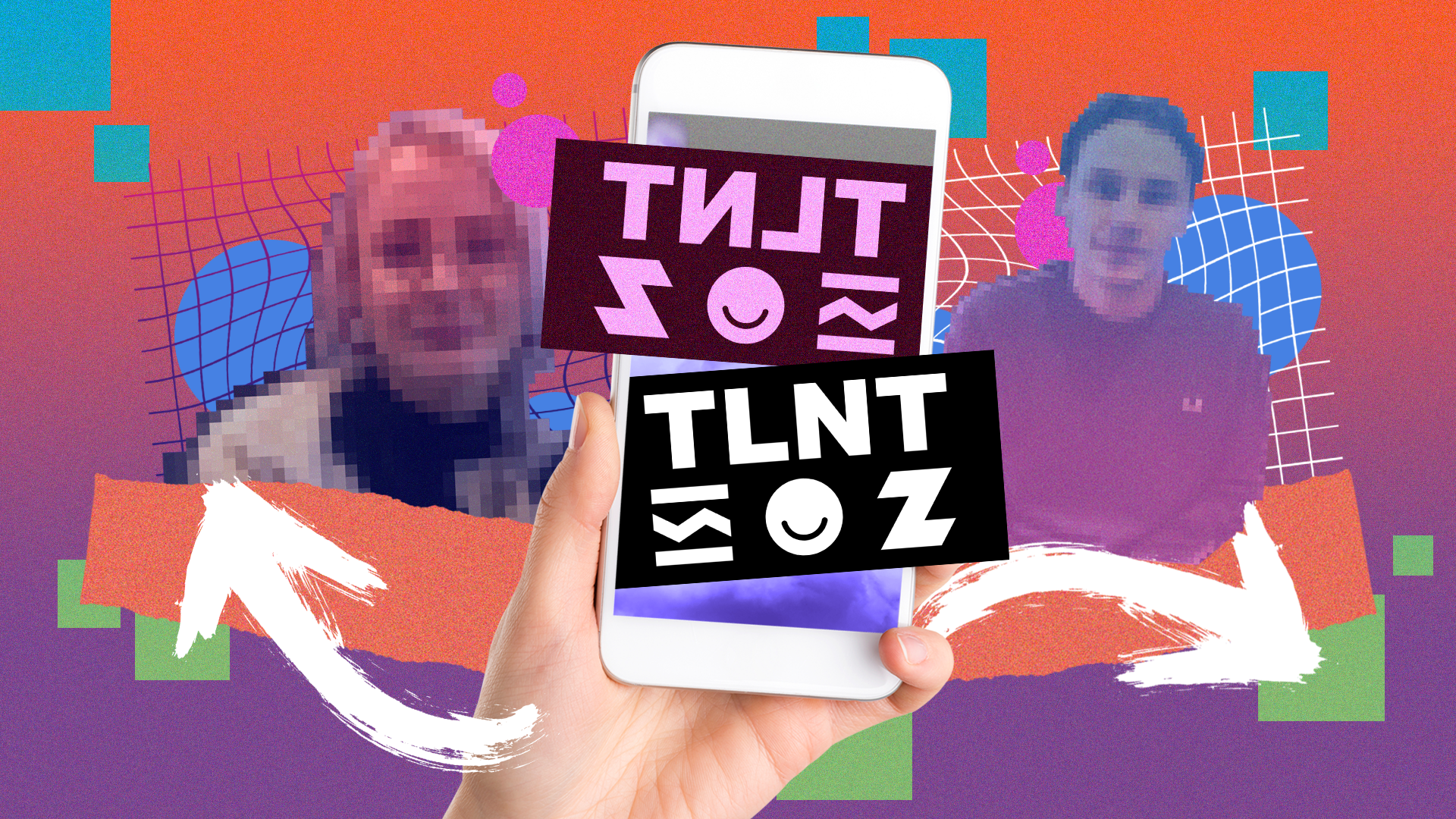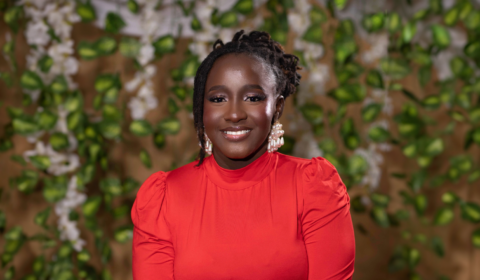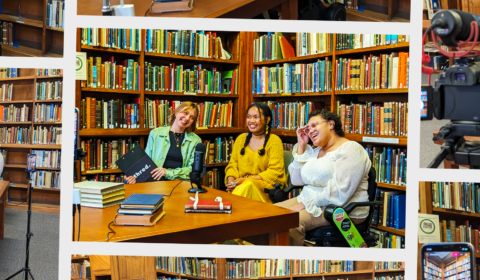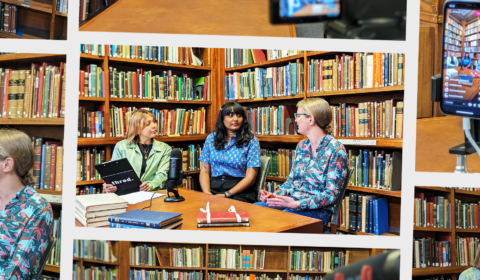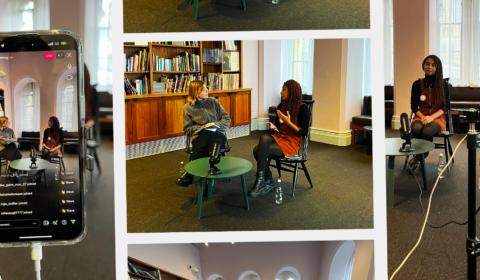Getting involved in the AR business
Augmented reality is an industry in its infancy, having only been commercially viable for a few years, but it’s potential is staggering. The industry is forecast to be worth over $200 billion by 2025 and is now fully integrated with the biggest social media apps. Ant explained how he first saw this potential for growth a few years ago.
‘The AR stuff only started kicking in around 2015’, he says, having previously worked in music tech and design. ‘I was living in LA at the time and that’s where I was first introduced to it’. The possibilities of augmented reality appealed to Ant’s interests in gaming and graphic design – and the idea for Aug It! quickly followed.
‘For me it was social media companies embracing these new technological innovations and getting in on the act in 2017. Before, it was mostly these apps that didn’t work very well, and then there was this sudden shift. I was in the middle of it all happening’.
Alex was equally as excited about the possibilities of AR before it began to truly explode. ‘I’ve been at TLNT for nearly three years now. We saw how this was the thing we’ve got to get our creatives on. It’s been our fastest growing category to date’. He also says that he’s seen a ‘lot of demand from creators who are keen to learn how to power their creativity using AR. We’re now excited to launch Reality House in 2021. This interest from creators combined with what our partners like Snapchat are looking to do will create magic!’
He compared AR filters to other mainstream content forms, stressing it ‘has engagement that’s four times that of video’. It’s these kinds of numbers that are pushing TLNT to focus more on AR than ever before.
All this expansion is great news, but what’s keeping young people so hooked on filters and novelty camera games that can only be achieved with AR? Ant says it’s a ‘different way of expressing yourself and your content. AR effects can enhance what you show to the world, it makes it all more interesting’.
To that end, Alex notes it’s the experience as a whole that keeps users coming back. ‘It’s super engaging, you share it with your friends, you want to try. Especially this year with the pandemic, the increase in digital experiences has encouraged people to get involved with it all’. For once it seems lockdowns may have actually helped out the business rather than act as a roadblock, which was oddly refreshing to hear.
Working and creating business in 2020
Aug It! has catered to a variety of clients recently, with a focus on popular musicians looking to cash in on social media followers. When asked about who’s been taking an interest, Ant says its been the entertainment industry first and foremost. ‘Musicians, record labels, beauty brands as well’.
His company has most recently collaborated with TLNT to produce AR camera effects for Warrior Cats and Dua Lipa, no less. You’ll probably have seen his work on Instagram and Snapchat as AR filters, each one promoting a single or album drop. He says these clients provide constant, quick work that keeps staff on their toes. ‘We finished one project and then four weeks later we’d have another project. You would never get that with certain brands… they would never regularly be pushing for new content like this, so it works well’.
Alex countered Ant’s point, however, by noting that some traditional brands are adopting AR for practical reasons outside of just viral content. ‘You do see some big companies like Made.com, Ikea, and other home goods companies using this augmented reality to see what products look like in your living room, to test out cars, that sort of thing’.
‘I’d agree that the quick and immersive stuff suits music, entertainment, and film, but especially now with Apple launching its own AR kit, I think a lot of this stuff is being used for utility as well as advertisement’. We should expect more of these innovations to infiltrate the mainstream – you can even see what animals look like through your camera on Google these days. The future is now.
Alex says we’re already seeing this happen. ‘I honestly think it’s like a confetti canon ready to explode, people that are in it and people who’re ahead of the curve know what’s coming. So I think it’s going to become more ubiquitous, people are going to get better phones, we’ve got Apple launching AR glasses in the next three years, and in-terms of what you can do with it I just think it’s going to take off’.
The state of the AR industry moving forward
With all this speak of mainstream attention, we wondered whether AR will be present at future in-person events when the pandemic subsides. Both Alex and Ant were confident that it would be. ‘Definitely, we did quite a lot of live stuff before the social media companies got on board. The first few projects were all live event apps,’ Ant explains. ‘I think next year it will be a part of every single event’.
Both have clear ambitions for the next few years of business, too. Ant is looking to go directly down the ‘consultancy angle’, with a few projects set to launch in January. He says we could see entire show floors for big brands like Mercedes move over to AR, though he warns it will be ‘several years’ worth of work to train staff and get things moving’.
For now, though, Ant’s been busy helping out at the London Wing Fest, where his company developed ‘3D chickens you could chase’ in 2018. He’s hoping to develop a long-term annual relationship with the event, though whether that’s for the free chicken or the AR benefits is up for debate.
Now Alex and Ant are busy developing and planning the launch of Reality.House – a platform dedicated to the education and inspiration of new and established creators producing AR. ‘The platform is part of TLNT and will be a great resource and place to collaborate and work on AR and VR projects! So watch out for this launching early 2021’.
Alex also envisions a world in which AR can exist outside of just your phone. ‘It’ll all be in your glasses of contact lenses. Imagine your local Starbucks pinging up with information as you walk past it. It’ll be a trippy experience, but I think that’s the future’. Perhaps a future similar to Cyberpunk 2077 isn’t that far off.
Advice for young creatives and artists heading into AR
Of course, the future has to come from young creators who are looking to get a foot into the industry, and Alex and Ant had some great advice to give future prospective Gen Z talent.
The first port of call is social media. Ant recommends finding out who made your favourite assets or content you see online and actively following their profiles. ‘The chances are you’re going to end up seeing content from someone like myself or other creative firms, and you’ll be opened up to whole new worlds’.
Self-teaching on mainstream apps like Adobe Photoshop and Illustrator is also a great idea. ‘A lot of these people will have YouTube accounts with tutorials where you can learn how to make visuals. You’ll realise you can do it too’.
Free software like Spark AR and Lens Studio are good options for those who can’t afford the pricey stuff, and may actually be more helpful in learning the ropes for virtual reality tools. Ant has even recently helped a young creator to produce AR camera effects for Warrior Cats, working with TLNT directly to boost opportunities for Gen Zers.
He advises to ‘download what’s out there, as a lot of companies put out basic help guides to get you started’. He’s also working on some tutorials himself for Aug It!, and says your best bet is to ‘just jump into it’. Alex echoed the importance of learning skills for yourself on a basic level, as they’re the ‘foundation set’ that’ll get you ‘up there and ready in no time’. Inspiring stuff.
Having a good portfolio is crucial to get the attention of employers, perhaps more so than anything else. Ant says that if you ‘show me a great portfolio, I’ll just ask you to work for us, regardless of your qualifications’. Product and output is key to making it big, and the more stuff you make the better, even if it isn’t perfect every time.
To round things off we asked how creators can best be discovered, and Ant recommends being active on ‘Instagram and LinkedIn’ as they’re the most busy places for finding talent. ‘People are definitely out there looking at what you’re doing’, though he also stresses that taking that first move yourself is just as effective. ‘It doesn’t hurt to look for work and get your face out there. There’s a community out there for you and it’s all about how you manage your own profile’. Self-starting is possible, it’s all in the social media game.
Regardless of where you stand with AR, there’s no doubt that it is taking over online content. Companies like Aug It! and TLNT are positioned perfectly to grow into formidable forces in entertainment, and we’re likely to only see them go up from here. Your favourite YouTubers are jumping onto the hype, with interactive games and timed features, alongside mainstream celebs and big household brand names. We’ve a feeling that we’re really only at the beginning.
As Alex says, we’ve only ‘scratched 1% of the surface’ when it comes to the potential of AR. We’ve a lot more in store yet, and you’d best stick around and keep in the loop. If you want to learn more about Aug It! you can visit the official website here, or visit the TLNT website here.
Remember us when you’re the next big shot AR creator hanging out with pop stars though, eh? Rope us into that London Wing Fest chicken deal too, especially if they have vegan options floating about. The more virtual 3D chicken races we have access to, the better.









